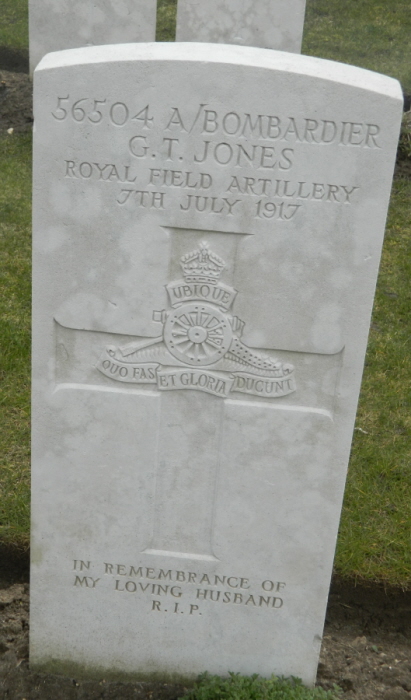
Whitby High School
Battlefields Tour 22nd-25th March 2013

 |
Whitby High SchoolBattlefields Tour 22nd-25th March 2013 |
 |
Thanks to the search team, and, of course, the patience of those still on the coach.
56504 Acting Bombadier G Thomas Jones, 23349 Sergeant Ellis Percival, 24318 Private Arthur Pratt, 24001 Private Edward Southern, What a team! Well done, and thanks to everyone involved.
56504 Acting Bombadier G Thomas Jones,
23349 Sergeant Ellis Percival, 24318 Private Arthur Pratt, 24001 Private Edward Southern,
Rifleman A. Royden

Etaples Military Cemetery,Pas de Calais
History
 During the First World War, the area around Etaples was the scene of immense concentrations of Commonwealth reinforcement camps and hospitals. It was remote from attack, except from aircraft, and accessible by railway from both the northern or the southern battlefields. In 1917, 100,000 troops were camped among the sand dunes and the hospitals, which included eleven general, one stationary, four Red Cross hospitals and a convalescent depot, could deal with 22,000 wounded or sick. In September 1919, ten months after the Armistice, three hospitals and the Q.M.A.A.C. convalescent depot remained. Today the cemetery contains 10,771 Commonwealth burials of the First World War, the earliest dating from May 1915. 35 of these burials are unidentified.
During the First World War, the area around Etaples was the scene of immense concentrations of Commonwealth reinforcement camps and hospitals. It was remote from attack, except from aircraft, and accessible by railway from both the northern or the southern battlefields. In 1917, 100,000 troops were camped among the sand dunes and the hospitals, which included eleven general, one stationary, four Red Cross hospitals and a convalescent depot, could deal with 22,000 wounded or sick. In September 1919, ten months after the Armistice, three hospitals and the Q.M.A.A.C. convalescent depot remained. Today the cemetery contains 10,771 Commonwealth burials of the First World War, the earliest dating from May 1915. 35 of these burials are unidentified.
Hospitals were again stationed at Etaples during the Second World War and the cemetery was used for burials from January 1940 until the evacuation at the end of May 1940. After the war, a number of graves were brought into the cemetery from other French burial grounds. Of the 119 Second World War burials, 38 are unidentified.
Etaples Military Cemetery also contains 662 Non Commonwealth burials, mainly German, including 6 unidentifed. There are also now 5 Non World War service burials here.
The cemetery, the largest Commission cemetery in France, was designed by Sir Edwin Lutyens.



Tracing Local Heroes
This was our final site visit, which was on our way up the coast road towards Calais. We had a specific purpose - a small search team would go into the cemetery with the intention of tracking down four Ellesmere Port men recorded on our local war memorial. Mr Royden was also hoping to find a cousin, Private A. Royden, who was the only remaining member of his family lost in WW1 he was yet to find. The cemetery is huge and it looked a daunting task, but the party split into groups, and within half an hour, all men had been found, photographs taken, respects paid, and the visitor book signed and we were again on our way home.
The men we were searching for:
D Battery, 104th Brigade, Royal Field Artillery. Husband of M Smith of 7 Hopehill Street, Pollokshaws, Glasgow, Son of John Jones and Brother to Joseph Jones. Died of Wounds on 10th July 1917. Plot XXII, Row M, Grave 19A.
‘C’ Company 9th Battalion Cheshire Regiment. Son of Charles and Martha Eleanor Percival of Ellesmere Port, Cheshire. 12th November 1918. Plot XLIX, Row F, Grave 9.
11th Battalion Cheshire Regiment. Died on 22nd December 1915. Plot VI, Row A, Grave 5A.
13th Cheshire Regiment. Husband of Ethel H Southern of 53 Lime Street, Ellesmere Port. Died of Wounds on 30th May 1916, Aged 30. Plot V, Row D, Grave 16.

D Battery, 104th Brigade, Royal Field Artillery. Husband of M Smith of 7 Hopehill Street, Pollokshaws, Glasgow, Son of John Jones and Brother to Joseph Jones. Died of Wounds on 10th July 1917. Plot XXII, Row M, Grave 19A. 



‘C’ Company 9th Battalion Cheshire Regiment. Son of Charles and Martha Eleanor Percival of Ellesmere Port, Cheshire. 12th November 1918. Plot XLIX, Row F, Grave 9. 


11th Battalion Cheshire Regiment. Died on 22nd December 1915. Plot VI, Row A, Grave 5A. 

13th Cheshire Regiment. Husband of Ethel H Southern of 53 Lime Street, Ellesmere Port. Died of Wounds on 30th May 1916, Aged 30. Plot V, Row D, Grave 16.


86590 1st/6th Bn. The King's (Liverpool Regiment), Died of wounds (gas), aged 18, 18 June 1918,
Son of George and Annie Royden. Native of Higher Bebington, Wirral.
Section LXVIII. E. 30.




